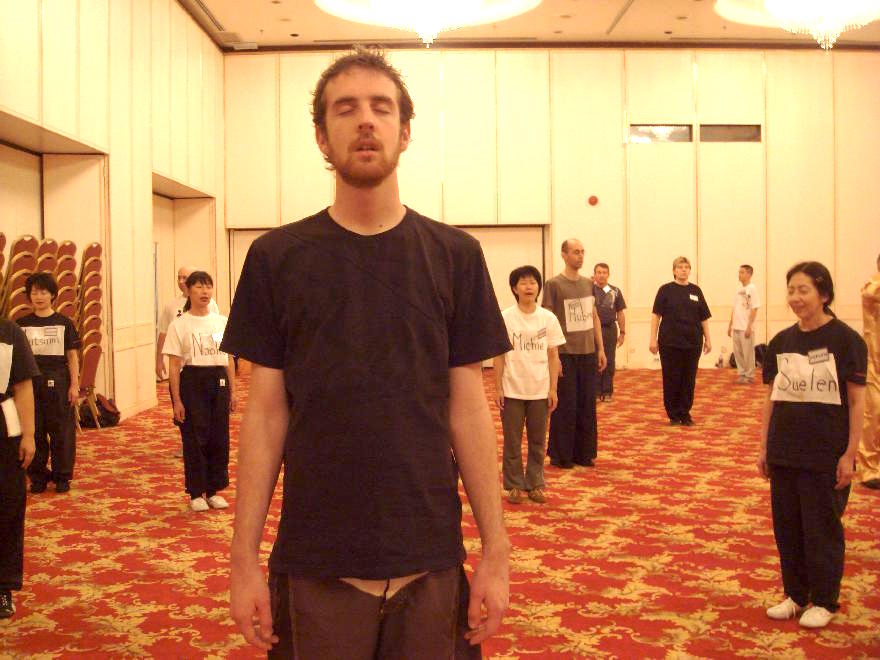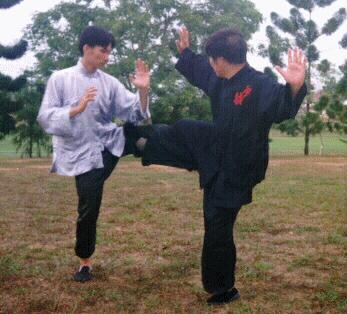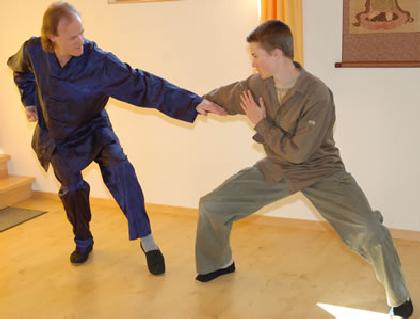January 2009 (Part 2)
SELECTION OF QUESTIONS AND ANSWERS

“Entering Silence”, also known as “Entering Tao”, “Entering Zen” or “Entering a Chi Kung State of Mind” is a fundamental skill all our students learn. Here participants enjoyed “Entering Tao” at the Intensive Taijiquan Course of September 2008 in Penang, Malaysia.
Question 1
I am male and 57 years young and a first year student in TCM at the Midwest College of Orient Medicine at Racine Wisconsin.
— David, USA
Answer
I am glad you say that you are only 57 years young, which is almost 10 years younger than me. If I consider myself young, those younger than me should not consider themselves old. Men, and of course that includes women, are made to last at least 120 years. Anyone before 60 years is not even middle age.
Your study of traditional Chinese medicine will provide you the philosophy on how to remain young even when you have passed 60. But merely knowing the philosophy is not enough, you also have to undergo the practice that keeps you young irrespective of your age. Chi kung and the internal martial arts are excellent for this purpose.
Question 2
I have been interested in Taoism and various forms of the martial arts but never committed to any one form, but instead attempt to understand the differences. I know now that I like and prefer the soft forms of Taijiquan and qigong. I would like to find a sifu who would be able to instruct me in “entering silence”.
Answer
I would suggest that you learn qigong or Wahnam Taijiqan from our certified instructors. Many people consider “entering silence:” an advanced skill, but it is one of the very first things you learn in our school.
Indeed, it is because our students can “enter silence” right at the beginning of their learning that they can practice qigong (chi kung) and Taijiquan as internal arts. Most other students who cannot “enter silence” practice only the external forms of qigong and Taijiquan. “Entering silence” is only the start. There are many wonderful things you can learn in our school.
Question 3
The college does not offer the subject and when I asked about it, I was told that they felt that everyone should choose their own master.
Answer
I don't mean to be presumptions; I am just saying the truth. It is difficult to find teachers who teach qigong and Taijiquan as internal arts, or who teach how to “enter silence”.
Hence, even when colleges offer these arts, they are usually taught as external exercise. And the governors or administrators of the colleges, despite their good intentions, do not know this fact.

“Differentiating Yin-Yang” is a very important concept in Taijiquan, but it is not often understood. Here, both Gradmaster Wong and Tai Chee Yong differentiate yin-yang, Yin represents the standing leg, and yang represents the kicking leg.
Question 4
I have been reading on the internal and external Qigong in my spare time, which is little to none.
Answer
One must be discriminating when seeking information from the internet. Much of what is written on the internet about qigong and other internal arts is incorrect and misleading.
There are also many “masters” who quote a lot of qigong and internal art sayings from classical literature, but often they themselves do not know what they are saying. It is easy for genuine masters to tell the rubbish from the genuine stuff, but the general public and ordinary students would not know.
Let me give you an example. Suppose you read the following from the internet. "Yin-yang harmony is very important in Taijiquan. Yin represents soft, gentle, moving backward, yielding and internal. Yang represents hard, powerful, moving forward, penetrating and external. Yin-yang must be expressed in every movement of Taijiquan.
An opponent attacks you with a punch. He is moving forward. You should move backward. This is yin-yang. He punches you with his right hand. You should ward of his punch with your left hand. This is yin-yang — left against right.
When you move back, you stamp you right foot on the ground and stand firm, while your left foot is light. You must remain soft, while your right leg is hard. Again this is yin-yang. After yielding by moving back, you move forward and drive a penetrating punch towards him . This is yin-yang.
Your opponent's strength is external. You should respond in an internal way. How is this achieved? Use the principle of yin-yang. When you move back and stamp your right foot on the ground, you send your internal force to the ground, the ground bounces back the internal force through you leg, through your body, controlled by your waist, along your arm and out of your punch. This is using whole-body movement, which is very important when applying your internal force.
As you punch your opponent, you must clench your fist so that you can hit him hard, but as soon as you hit him, you must relax your whole body and be soft. This is how yin-yang works for internal force. If you understand these secrets, which were kept by Taijiquan masters in the past, you would have attained the essence of Taijiquan."
What do you think of the above quoatation? If you, like many others who study Taijiquan, think that the above contains invaluable information on Taijiquan, you are grossly mistaken. The above is rubbish, but it is not uncommon in the internet. This and similar writings are made by some Taijiquan “masters” who copied Taijiquan principles from the classics but without understanding or practicing them.
Question 5
I have two beautiful children 8 and 14 that are refreshing and demanding.
Answer
Being a good father and husband is one of the best blessings any man can have.
Question 6
Is there anyone in my area who knows the healing practices of Qigong?
Answer
Please refer to my list of certified instructors. If you are passionate about qigong, I would strongly recommend that you attend my Intensive Chi Kung Course. Please see my website.

Sifu Andrew withdraws his front leg into a False-Leg Stance as he counters Bjoern's Precious Duck attack. Sifu Andrew's movement may be what was referred in the past as “Withdrawing Step”. Bjorn's stance, known today as Eight-Tenth Horse-Riding, was known in the past as “Divide-Body Stance”.
Question 7
I have been experiencing a massive amount of Qui energy radiating from inside my stomach and exits out my hands. I need guidance and direction. I am afraid if I touch someone I will disrupt their positive flow of energy or hurt them.
— Allen, USA
Answer
I assume that when you wrote “qui”, you meant “qi”, which is the Chinese word for “energy”.
Everyone has “qi”, but you have more “qi” than average people. This is probably due to some events in your past lives, like having spent much time practicing qigong or spiritual cultivation.
You need not worry about your more than normal qi in your body, though it may sometimes cause some concern to you and other people. Nevertheless, you should learn to control it. An excellent way is to learn chi kung from a competent teacher. Then you will be able to turn your excessive qi or energy to good use.
Question 8
I am currently researching the connection of the Korean martial arts to the Chinese martial arts. Many of the ancient Korean military texts drew heavily from Chinese texts such as the “Bubishi” and Qi Ji Kwang's “New Book of Practical Military Tactics”.
In one of the Korean texts it mentions 35 hand techniques and 18 steps. I found a Chinese equivalent written in 1625 and I hope you could help me identify the steps or stances.
In case the Chinese characters don't show up in this email, here is the link to a thread I posted on your forum: http://www.wongkiewkit.com/forum/showthread.php?t=7710. Also the text I pulled this from is linked here http://lwdao.pinsou.com.cn/?action=t...%7C4375%7C2829, which seems to be a text from 1675.
— Dan, USA
Answer
Please note that the answers I give below are to the best of my knowledge and may be mistaken. It is best if you can counter-check with some other masters or scholars who are more knowledgeable.
The numbers refer to the items you listed in the e-mail as well as in your post in our forum, where you need answers.
5. “Disperse” Step, which may be figuratively translated as retreat step, refers to moving your front leg diagonally backward. Suppose you are at a Bow-Arrow Stance facing north with your right leg in front. A retreat step here refers to moving your right leg backward to south-east diagonally behind your left leg. Your new stance may still be Bow-Arrow or at any other stance.
8. Withdrawing Step. I am sorry I do not know what this step is. But I guess it may mean moving from a forward stance, like a Bow-Arrow, to a withdrawn stance, like a False-Leg or a Unicorn Step.
10. Hook Step. You hook your foot into an opponent's stance. For example, your opponent is standing at a right Bow-Arrow Stance. You move your right foot from your right side forward into his front leg hooking his right front foot. Your right leg is still in on the ground. You may use any stance for this movement, like a right Bow-Arrow Stance or a right False-Leg Stance.
12. Fairy Step. It is standing upright with your feet pointing forward and about a foot or one and a half feet apart.
13. Divide-Body Stance. Here your stance points to one direction, but your body points to another direction. Suppose you are at a Horse-Riding Stance with your right leg towards the north, your left leg towards the south, and your stance points towards the west. Normally at this Horse-riding Stance your body and face will point towards the west too. But you turn your body towards north-west, and your face towards north. In this position you are at a Divide-Body Horse Stance.
14. Turning-Body Step. Here you use your footwork to help in turning your body, such as when performing a Shaolin pattern called “Continous Hanging Kicks”. Suppose you face north. You swing a high right hanging kick (like a round-house kick in Taekwondo) towards the north. At the completion of the first kick, your turn to face south, place your right leg on the ground and swing a high left reverse hanging kick (like a reverse round-house kick in Taekwondo) towards the north. While the second kick is still in the air, you jump up with a third high right hanging kick towards the north. The footwork used is called Turning-Body Step.
15. Chase Step. You use this footwork to chase after a retreating opponent. Suppose you are at a right Bow-Arrow Stance. As your opponent retreats, you place your left back leg immediately behind your right front leg, and immediately move your right front leg forward. Then you place your left back leg immediately behind your right front leg, and move your right front leg forward to a right Bow-Arrow Stance again.
16. Press Step. You use this footwork to press into an opponent. Suppose you strike your opponent with your right fist at your left Bow Arrow Stance. Without moving his feet, your opponent slants his body backward to avoid your punch. You move your left leg forward followed by your right leg, still at your left Bow Arrow Stance, and strike your opponent again. This is Press Step.
17. Inclined Step. Here your slant your body backward without moving your stance. Suppose you are at a right Bow-Arrow Stance facing north. Your opponent executes a side kick at you. Without moving your feet, you slant your body backward to avoid the kick. In this Inclined Step your left back leg is bent and your right front leg is straight. Your body is turned towards west, but you look towards your opponent at north.
18. Strangle Flower Step. This is what we call Unicorn Step. You cross your two legs, placing the knee of one leg behind the knee of the other leg. Both legs are bent. One heel is raised.
LINKS
Selected Reading
- Solo Practice and Combat Application of Four Gates - Old Videos
- Smile from the Heart
- An Effective Response Against Any Kicks
- When Can We Come Again?
- Calling a Cow a Horse
